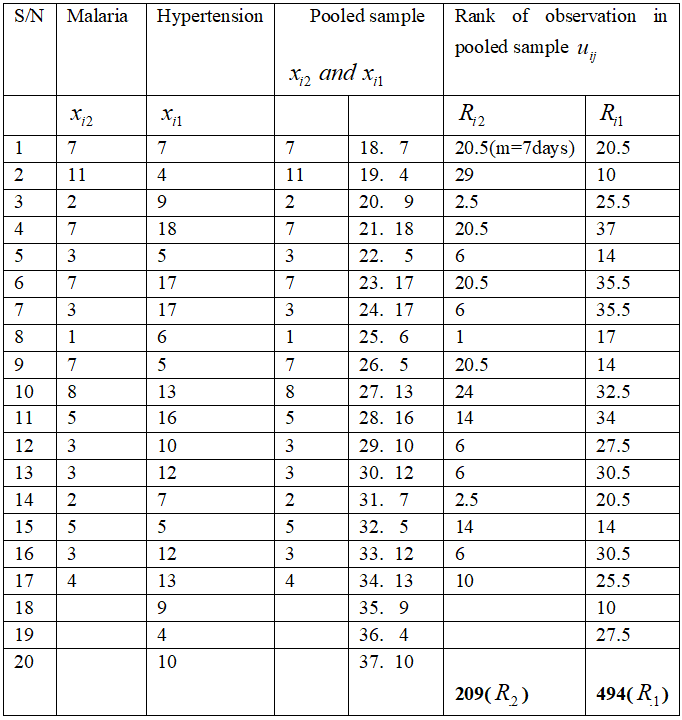Intrinsically Ties Adjusted Median Test for Determining the Lengths of Hospitalization of Sampled Patients with Hypertension and Malaria in A Population
Clinical Medicine And Health Research Journal,
Vol. 4 No. 6 (2024),
20 November 2024
,
Page 1037-1045
https://doi.org/10.18535/cmhrj.v4i6.414
Abstract
Background: This paper proposes and presents a nonparametric statistical method for the analysis of two sample data that intrinsically and structurally adjusts the test statistic, for the possible presence of tied observations in the sample populations.
Methodology: The proposed procedure makes it unnecessary to require the populations to be continuous as is often the case with some other methods. The populations may be measurement on as low as the ordinal scale and need not be continuous or even numeric. In situations where the original or initial null hypothesis is rejected, test statistics are developed to help determine which of the two populations of interest may be responsible for the rejection of the null hypothesis, an approach that is not possible for some other existing two sample median test.
Results: The proposed method is illustrated with some sample data and shown using the data to compare favorably with the usual median test and the Mann-Whitney U-test that could be used for the same purpose. Result showed that we rejected the null hypothesis, that hypertension and malaria patients from the population admitted to a hospital for treatment do not have equal median lengths of hospitalization for hypertension and malaria. Since The Chi-square value for testing the null hypothesis that the median length of hospitalization of hypertension patients in the population is equal to the median length of hospitalization of both hypertension and malaria patients in the population when pooled together as one population, is which with 1 degree of freedom is not statistically significant at the 5 percent significance level leading to the non-rejection of the null hypothesis. the Chi-Square value for testing the same null hypothesis with respect to malaria patients, that is that the median length of hospitalization of malaria patients in the population is the same as the median length of hospitalization of the combined or pooled population of hypertension and malaria patients when combined and treated as one population is which with 1 degree of freedom is statistically significant at the 5 percent significance level leading to the rejection of the null hypothesis.
Conclusions and recommendations: We conclude that hypertension and malaria patients in the population do not have equal median lengths of hospitalization. We may therefore conclude that the median length of hospitalization of malaria patients is statistically different from the median length of hospitalization of both hypertension and malaria patients in the sampled population and may hence be responsible for the rejection of the initial null hypothesis H0 of Equation 11 or 12 of equal population median lengths of hospitalization of the two types of patients in the sampled population. since the Chi-square value of obtained using the proposed modified ties adjusted median test for two samples is much larger than the Chi-square value of obtained using the usual ordinary unmodified ties unadjusted two sample median test, the proposed method is likely to correctly reject a false null hypothesis more often and hence is more powerful than the ordinary median test when used to analyze the same sample observations.
- : Intrinsically, Structurally, Mann-Whitney U-test, tied observations, two sample median test

How to Cite
Download Citation
References
- Article Viewed: 0 Total Download


